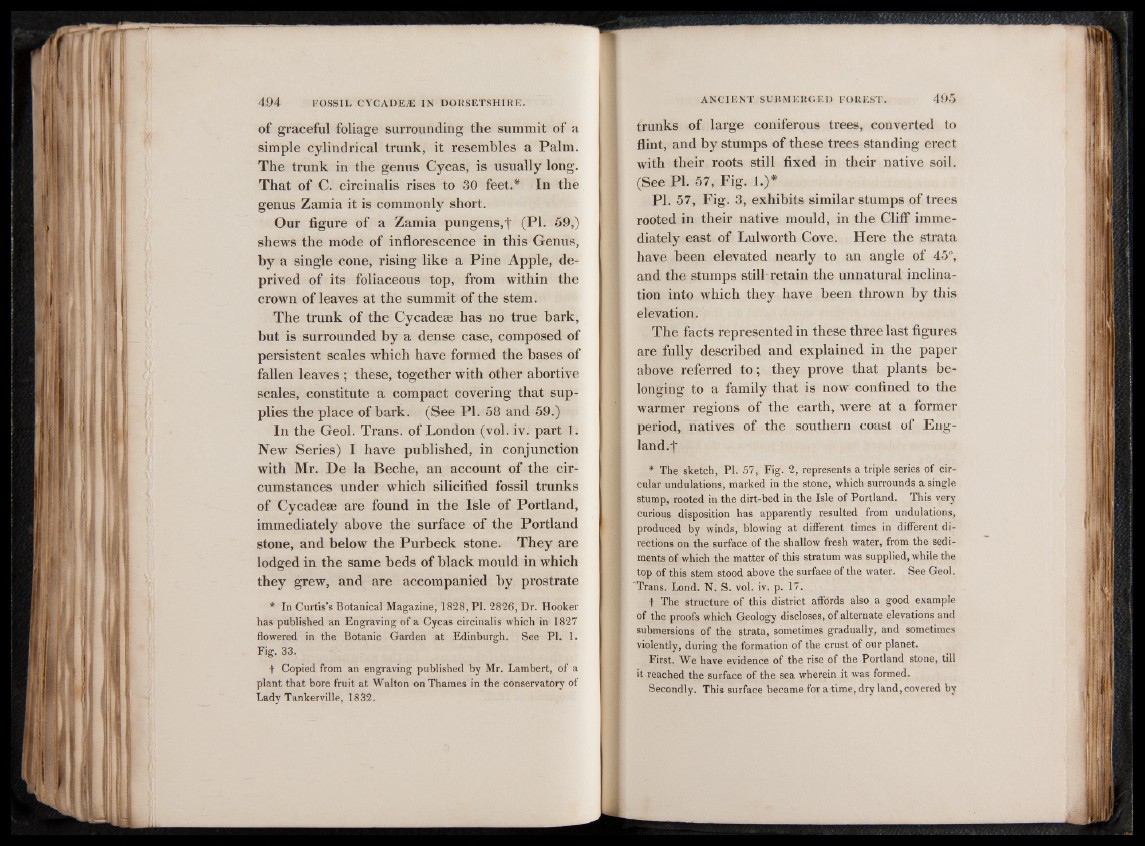
of graceful foliage surrounding the summit of a
simple cylindrical trunk, it resembles a Palm.
The trunk in the genus Cycas, is usually long.
That of C. circinalis rises to 30 feet.* In the
genus Zamia it is commonly short.
Our figure of a Zamia pungens,| (PI. 59,)
shews the mode of inflorescence in this Genus,
by a single cone, rising like a Pine Apple, deprived
of its foliaceous top, from within the
crown of leaves at the summit of the stem.
The trunk of the Cycadeae has no true bark,
but is surrounded by a dense case, composed of
persistent scales which have formed the bases of
fallen leaves ; these, together with other abortive
scales, constitute a compact covering that supplies
the place of bark. (See PI. 58 and 59.)
In the Geol. Trans, of London (vol. iv. part Kt
New Series) I have published, in conjunction
with Mr. De la Beche, an account of the circumstances
under which silicified fossil trunks
of Cycadeae are found in the Isle of Portland,
immediately above the surface of the Portland
stone, and below the Purbeck stone. They are
lodged in the same beds of black mould in which
they grew, and are accompanied by prostrate
* In Curtis’s Botanical Magazine, 1828, PI. 2826, Dr. Hooker
has published an Engraving of a Cycas circinalis which in 1827
flowered in the Botanic Garden at Edinburgh. See PI. 1.
Fig. 33.
f Copied from an engraving published by Mr. Lambert, of a
plant that bore fruit at Walton on Thames in the conservatory of
Lady Tankerville, 1832.
trunks of large coniferous trees, converted to
flint, and by stumps of these trees standing erect
with their roots still fixed in their native soil.
(See PI. 57, Fig. 1.)*
PL 57, Fig. 3, exhibits similar stumps of trees
rooted in their native mould, in the Cliff immediately
east of Lulworth Cove. Here the strata
have been elevated nearly to an angle of 45°,
and the stumps still retain the unnatural inclination
into which they have been thrown by this
elevation.
The facts represented in these three last figures
are fully described and explained in the paper
above referred to ; they prove that plants belonging
to a family that is now confined to the
warmer regions of the earth, were at a former
period, natives of the southern coast of England.
f
* The sketch, PL 57, Fig. 2, represents a triple series of circular
undulations, marked in the stone, which surrounds a single
stump, rooted in the dirt-bed in the Isle of Portland. This very
curious disposition has apparently resulted from undulations,
produced by winds, blowing at different times in different directions
on the surface of the shallow fresh water, from the sediments
of which the matter of this stratum was supplied, while the
top of this stem stood above the surface of the water. See Geol.
Trans. Lond. N. S. vol. iv. p. 17.
t The structure of this district affords also a good example
of the proofs which Geology discloses, of alternate elevations and
submersions of the strata, sometimes gradually, and sometimes
violently, during the formation of the crust of our planet.
First. We have evidence of the rise of the Portland stone, till
it reached the surface of the sea wherein it was formed.
Secondly. This surface became for a time, dry land, covered by